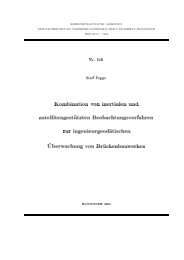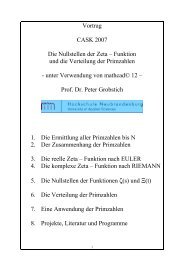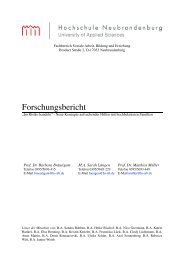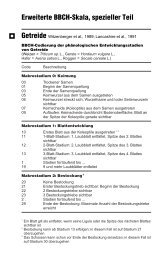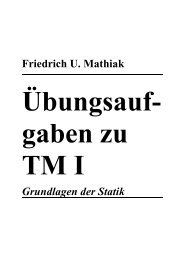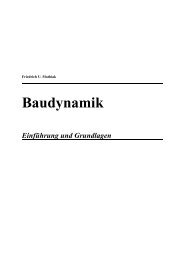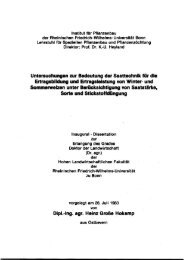2 - userwww.hs-nb.de - Hochschule Neubrandenburg
2 - userwww.hs-nb.de - Hochschule Neubrandenburg
2 - userwww.hs-nb.de - Hochschule Neubrandenburg
Sie wollen auch ein ePaper? Erhöhen Sie die Reichweite Ihrer Titel.
YUMPU macht aus Druck-PDFs automatisch weboptimierte ePaper, die Google liebt.
Prof. Dr. F.U. Mathiak, Hoc<strong>hs</strong>chule Neubran<strong>de</strong><strong>nb</strong>urg 41<br />
sprechen<strong>de</strong>n k-ten Reihe jene Summan<strong>de</strong>n sind und in <strong>de</strong>n übrigen Reihen mit D übereinstimmen.<br />
c<br />
c<br />
c<br />
c<br />
11<br />
21<br />
31<br />
41<br />
c<br />
c<br />
c<br />
c<br />
12<br />
22<br />
32<br />
42<br />
a<br />
a<br />
a<br />
a<br />
1<br />
2<br />
3<br />
4<br />
+ b<br />
1<br />
+ b<br />
+ b<br />
+ b<br />
2<br />
3<br />
4<br />
c<br />
c<br />
c<br />
c<br />
14<br />
24<br />
34<br />
44<br />
=<br />
c<br />
c<br />
c<br />
c<br />
11<br />
21<br />
31<br />
41<br />
c<br />
c<br />
c<br />
c<br />
12<br />
22<br />
32<br />
42<br />
a<br />
a<br />
a<br />
a<br />
1<br />
2<br />
3<br />
4<br />
c<br />
c<br />
c<br />
c<br />
14<br />
24<br />
34<br />
44<br />
+<br />
c<br />
c<br />
c<br />
c<br />
11<br />
21<br />
31<br />
41<br />
c<br />
c<br />
c<br />
c<br />
12<br />
22<br />
32<br />
42<br />
b<br />
b<br />
b<br />
b<br />
1<br />
2<br />
3<br />
4<br />
c<br />
c<br />
c<br />
c<br />
14<br />
24<br />
34<br />
44<br />
Satz 4-4<br />
Ein <strong>de</strong>n Elementen einer Reihe gemeinsamer Faktor darf vor die Determinante gezogen wer<strong>de</strong>n.<br />
a<br />
a<br />
a<br />
11<br />
21<br />
31<br />
λa<br />
λa<br />
λa<br />
12<br />
22<br />
32<br />
a<br />
a<br />
a<br />
13<br />
23<br />
33<br />
a<br />
= λ ⋅ a<br />
a<br />
11<br />
21<br />
31<br />
a<br />
a<br />
a<br />
12<br />
22<br />
32<br />
a<br />
a<br />
a<br />
13<br />
23<br />
33<br />
Satz 4-5<br />
Sind die Elemente einer Reihe lauter Nullen, so hat die Determinante <strong>de</strong>n Wert Null.<br />
a<br />
a<br />
11<br />
0<br />
31<br />
a<br />
a<br />
12<br />
0<br />
32<br />
a<br />
a<br />
13<br />
0<br />
33<br />
= 0<br />
Satz 4-6<br />
Sind die Elemente zweier paralleler Reihen zueinan<strong>de</strong>r proportional, o<strong>de</strong>r stimmen zwei Reihen<br />
überein, so hat die Determinante <strong>de</strong>n Wert Null.<br />
a<br />
a<br />
a<br />
11<br />
21<br />
31<br />
λa<br />
λa<br />
λa<br />
11<br />
21<br />
31<br />
a<br />
a<br />
a<br />
13<br />
23<br />
33<br />
= 0<br />
a<br />
a<br />
a<br />
11<br />
21<br />
21<br />
a<br />
a<br />
a<br />
12<br />
22<br />
22<br />
a<br />
a<br />
a<br />
13<br />
23<br />
23<br />
= 0<br />
Satz 4-7<br />
Sind A und B beliebige quadratische n-reihige Matrizen, so gilt:<br />
A ⋅ B =<br />
A<br />
B<br />
Beispiel 4-5<br />
Berechnung <strong>de</strong>r Determinante einer oberen Dreiecksmatrix



